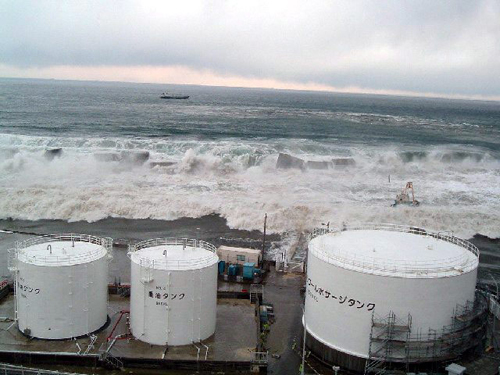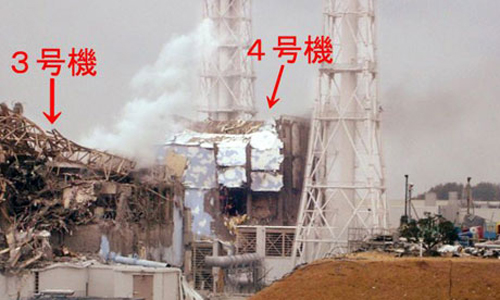Foto da Fukushima
Le immagini raccolte dal fotografo Dominc Nahr nell'area attorno alla centrale di Fukushima Daiichi, danneggiata dallo tsunami che ha colpito il Giappone a marzo.
Le immagini raccolte dal fotografo Dominc Nahr nell'area attorno alla centrale di Fukushima Daiichi, danneggiata dallo tsunami che ha colpito il Giappone a marzo.

Sono state rilasciate nuove foto dello tsunami che si è abbattuto sulla centrale nucleare giapponese di Fukushima Daiichi.
Tre mesi per fermare definitivamente ogni possibile fuga radioattiva e arresto a freddo entro sei, nove mesi.
Questo il piano della Tepco per risolvere in modo definitivo l'incidente nucleare di Fukushima in seguito allo spaventoso tsunami che ha devastato la costa nord orientale del Giappone.
Lontano dai comodi allarmismi per calcolo politico e dai titoli strillati sui quotidiani nazionali, la stessa Agenzia per la sicurezza nucleare giapponese spiega perché l'incidente provocato dallo tsunami a Fukushima non comporterà gli stessi rischi per la salute dell'evento sovietico, nonostante ne abbia elevato il livello dell'incidente allo stesso grado della scala INES. Il che per inciso ha fatto alzare più di un sopracciglio nella comunità scientifica proprio per l'evidente differenza tra i due casi.
E' stato aggiunto che la correzione di livello è da attribuirsi all'impatto iniziale che ha innalzato la radioattività dell'area a livelli critici e non alla situazione attuale. Il ritardo nell'annuncio è dovuto alla volontà di raccogliere, confrontare e esaminare quanti più dati possibili.
Tuttavia si continua a trattare di due episodi differenti per dinamiche e conseguenze.
A Fukushima infine le sostanze radioattive emesse sono state solo il 10% circa di quelle rilevate a Chernobyl.
Chernobyl exploded while the reactors were still active, which is completely different from the situation at Fukushima.
[...] The emission of radioactive substances from Fukushima Daiichi was about 10% of that detected at Chernobyl.
L'incredibile video del giornalista giapponese Tetsuo Jimbo nel suo viaggio all'interno dell'area interdetta attorno ai reattori della centrale nucleare di Fukushima.
Il New York Times pubblica la situazione aggiornata dei reattori della centrale nucleare di Fukushima Daiichi.

La crisi alla centrale nucleare di Fukushima Daiichi in diretta.
L'esperto di programmi di sviluppo nucleare, Mark Hibbs, spiega al Deutsche Welle perché Fukushima non può trasformarsi in un'altra Chernobyl.
So now we have the reactor shutdown generating heat from the hot fuel but no cooling systems. So that is the same basic scenario that we had in Three Mile Island.
That is not the same, by any means, as the accident at Chernobyl in 1986, where because the reactor had a completely different design, the physics of the reactor produced a power excursion and that led to an explosion of the reactor under conditions in which the reactor had no containment to withstand the pressure from the blast.
And we know what happened: a hole was blown out from the side of the reactor, and a large amount of the radioactive inventory from the fuel was propelled outside of the reactor building. That cannot happen here. These reactors are water-moderated. They're not graphite-moderated. There won't be any power excursion of this kind. That's just physically not possible.
L'agenzia Kyodo riepiloga la situazione dei dieci reattori nelle due centrali nucleari di Fukushima.
Fukushima Daiichi.
Reactor No. 1 - Cooling failure, partial melting of core, vapor vented, hydrogen explosion, seawater pumped in.
Reactor No. 2 - Cooling failure, seawater pumped in, fuel rods fully exposed temporarily, damage to containment system, potential meltdown feared.
Reactor No. 3 - Cooling failure, partial melting of core feared, vapor vented, seawater pumped in, hydrogen explosion, high-level radiation measured nearby.
Reactor No. 4 - Under maintenance when quake struck, fire caused possibly by hydrogen explosion at pool holding spent fuel rods, pool water levels feared receding.
Reactor No. 5 - Under maintenance when quake struck.
Reactor No. 6 - Under maintenance when quake struck.Fukushima Daini.
Reactor No. 1 - Cooling failure, then cold shutdown.
Reactor No. 2 - Cooling failure, then cold shutdown.
Reactor No. 3 - Cold shutdown.
Reactor No. 4 - Cooling failure, then cold shutdown.
Il professore David Hinde, a capo del dipartimento di fisica nucleare all'Australian National University, spiega l'importanza dell'acqua nel determinare la gravità della crisi nucleare ai reattori di Fukushima Daiichi.
We should always think about the worst case but if the water is simply boiling, and there is access to it, there is no danger to anybody – certainly outside the plant.
As long as the water level can be maintained, that shouldn't be a serious problem. The fact it is unit number 4, which was not operating at the time of the earthquake, means there should be no problems gaining access... I would worry more about the pool of reactor number 2.
If the water did boil away, there might be a problem.
The question is whether the zirconium alloy cladding could react with the steam and lose its containment ability. That, I'm not sure about.
I believe the upper part of the building is still largely intact, but a report suggested it may have been slightly damaged from the explosion in number 4. "The cladding should restrict the egress of radioactive material but if it's slightly compromised it will not be as effective as it would be ideally.